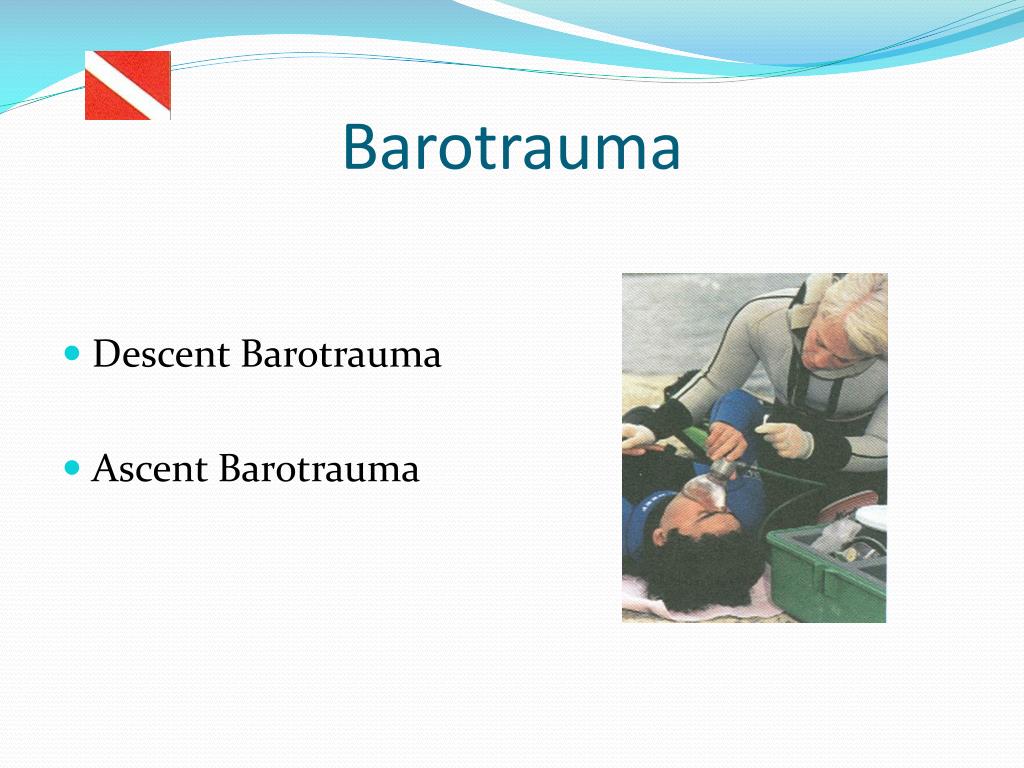

This is a higher success rate than seen in the reviewed studies (4,5) of topical oxymetazoline (36) or oral pseudoephedrine (68) and only exceeded by the study (6.

Barotrauma to the ear is the most common type of barotrauma. In Table 7, the authors acknowledge that the studies of nasal balloon use for symptoms of otic barotrauma reported 76 success in improvement and 80 success in relief of symptoms.

We review the causes, prevention and treatment of this condition. Barotrauma means damage to ear tissues caused by a difference in pressure between air spaces inside the body.
Barotrauma otic trial#
The third trial showed that oxymetazoline decongestant nasal spray, taken 30 minutes before descent, did not produce a statistically significant reduction in symptoms of barotrauma in adults with recurrent ear pain during air travel. Barotrauma is a recognised complication of mechanical ventilation that can occur in any patient receiving mechanical ventilation, but is most commonly associated with acute respiratory distress syndrome. Of three randomized controlled trials, one showed that oral pseudoephedrine decongestants reduced otalgia in adults with recurrent ear pain during air travel, whilst another found that oral pseudoephedrine did not decrease in-flight ear pain in children. Otic barotrauma is ear pain or damage to the tympanic membrane caused by rapid changes in pressure. Severe cases may result in tympanic membrane perforation and even round window membrane rupture. It is a common problem, presenting with ear fullness, otalgia and deafness. The pressure difference occurs because of failure of the eustachian tube to equilibrate middle ear and atmospheric pressures. © 2018, Otology & Neurotology, Inc.Otic barotrauma occurring during air travel involves traumatic inflammation of the middle ear, caused by a pressure difference between the air in the middle ear and the external atmosphere, developing after ascent or more usually descent. A recently reported, novel technique for insertion of temporary tympanostomy tubes is promising but requires further evaluation. There is insufficient evidence to support the efficacy of either nasal balloon inflation or pressure-equalizing ear plugs for the prevention of otic barotrauma. However, oral pseudoephedrine (1 mg/kg) does not appear to be effective in children. Middle ear barotrauma during flight is a painful disorder experienced by passengers who cannot properly regulate their middle ear pressure in response to. There is level 1 evidence that supports the efficacy of oral pseudoephedrine (120 mg) in preventing otic barotrauma in adults. This review highlights the lack of published evidence relating to what is a significant and increasingly common problem in otology. Barotrauma is a particular category of otologic trauma that is caused by the relatively gradual changes in ambient pressure experienced most frequently during the transition from lower to higher pressure (i.e., during descent). Data Extraction:Īrticles and data were extracted and analyzed according to Preferred Reporting Items for Systematic Reviews and Meta-Analyses and other international guidelines. Outcomes of interest were reduced severity or the successful prevention of otic barotrauma in participants undergoing gradual changes in pressure during air travel or its simulation. Symptoms may include sensorineural hearing loss and/or vertigo if which of the following develops There are 2 questions to complete. Study Selection:Įnglish language articles including more than or equal to five participants or cases were included. Otic barotrauma is ear pain or damage to the tympanic membrane caused by rapid changes in pressure.
Barotrauma otic full#
Ten databases including Embase, MEDLINE, the Cochrane Database of Systematic Reviews, and the Cochrane Central Register of Controlled Trials were searched using the full historical range. 4 While middle ear barotrauma can cause enough inflammation within the middle ear to result in conductive hearing loss, it may also be transmitted to the inner ear, causing a sensorineural hearing loss. In particular, this review sought to identify procedures, techniques, devices, and medications for the prevention of otic barotrauma as well as evaluate the evidence relating to their efficacy. Otic barotrauma results from a pressure differential between the middle ear and the external environment. To conduct a systematic review of the published evidence relating to the prevention of otic barotrauma in aviation.


 0 kommentar(er)
0 kommentar(er)
